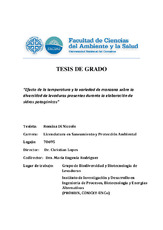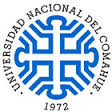- RDI Home
- →
- Facultad de Ciencias del Ambiente y la Salud
- →
- Tesis de Grado
- →
- View Item
JavaScript is disabled for your browser. Some features of this site may not work without it.
| dc.contributor.advisor | Lopes, Christian | es_ES |
| dc.contributor.other | Rodríguez, María Eugenia | es_ES |
| dc.coverage.spatial | ARG | |
| dc.creator | Di Niccolo, Romina | |
| dc.date | 2019 | |
| dc.date.accessioned | 2019-11-13T17:28:36Z | |
| dc.date.available | 2019-11-13T17:28:36Z | |
| dc.identifier | http://rdi.uncoma.edu.ar/handle/uncomaid/15526 | |
| dc.description.abstract | Las levaduras son microorganismos responsables de la transformación del mosto de manzana en sidra base, mediante el proceso metabólico conocido como fermentación alcohólica. Durante este proceso las levaduras no solo producen etanol y CO2, sino que también un gran número de metabolitos que contribuyen a la complejidad en el aroma y el sabor de la sidra. Aun cuando la especie de levadura más ampliamente involucrada en las fermentaciones del mundo es Saccharomyces cerevisiae, también se ha reportado la presencia de la especie criotolerante Saccharomyces uvarum, principalmente asociada a fermentaciones realizadas a bajas temperatura. La fermentación a baja temperatura permite conservar mejor los compuestos volátiles relacionados con el aroma, por lo que disponer de levaduras criotolerantes para estos procesos es de suma importancia. El objetivo de este trabajo fue estudiar y analizar la biodiversidad de levaduras indígenas asociadas a procesos de elaboración de sidras, utilizando mostos de una sidrera de la región del Alto Valle de Río Negro (Norpatagonia Argentina). Para este análisis se evaluó el efecto de la temperatura de fermentación y la variedad de manzana, con el objetivo de evidenciar la influencia de estas variables sobre la biota de levaduras en fermentaciones naturales (espontáneas). El aislamiento y recuento de las levaduras se realizó en un medio completo no selectivo. La identificación se realizó utilizando métodos fisiológicos para obtener una primera clasificación en función del tipo de esporulación, forma de la colonia y temperatura de crecimiento. Posteriormente se seleccionaron entre 2 y 4 colonias de cada grupo para realizar la determinación a nivel de especie por secuenciación del dominio D1/D2 del gen ribosomal 26S, las secuencias obtenidas fueron analizadas por BLASTn. Con las colonias identificadas dentro género Saccharomyces que no pudieron ser caracterizadas a nivel de especie con esta técnica, se realizó PCR-RFLP de 6 genes nucleares. Se pudo identificar la especie Saccharomyces uvarum, asociada a un ambiente de fermentación industrial (Mosto Red Delicious a 13°C) por primera vez en todo el continente. En los estadios iniciales de fermentación se observó la mayor diversidad de especies, independientemente del mosto y temperaturas evaluadas, identificándose en todos los casos solo a especies no-Saccharomyceticas. En mayoría de los casos analizados, se observó la mayor diversidad de especies en las fermentaciones realizadas a 13°C indicando que las temperaturas bajas permiten conservar la diversidad incluso en los estadios medios y finales de fermentación, independientemente del mosto utilizado. Por último, en cuanto a las propiedades cinéticas y fisicoquímicas de las sidras obtenidas, se observó que las fermentadas a 25°C tuvieron una cinética similar y menor tiempo de fermentación, mientras que en las fermentadas a 13°C se observó una cinética superior en mosto Red Delicious donde dominó la fermentación la especie S. uvarum. Además, estas sidras presentaron una menor acidez volátil, características de interés en la industria sidrera. | es_ES |
| dc.description.abstract | Yeasts are microorganisms responsible for the transformation of apple must intocider base, through the metabolic process known as alcoholic fermentation. During this process, yeasts not only produce ethanol and CO2, but also a large number of metabolites that contribute to the complexity in the aroma and flavor of cider. Although the yeast species most widely involved in the fermentations of the world is Saccharomyces cerevisiae, the presence of the cryo-tolerant species Saccharomyces uvarum has also been reported, mainly associated with fermentations carried out at low temperatures. The fermentation at low temperature allows to preserve the volatile compounds related to the aroma better, so having cryo-tolerant yeasts for these processes is of the utmost importance. The objective of this work was to study and analyze the biodiversity of indigenous yeasts associated with cider making processes, using the majority of a cider from the Alto Valle region of Río Negro (Norpatagonia Argentina). For this analysis, the effect of fermentation temperature and apple variety was evaluated, with the aim of demonstrating the influence of these variables on the biota of yeasts in natural (spontaneous) fermentations. The isolation and counting of yeasts was performed in a complete non-selective medium. The identification was made using physiological methods to obtain a first classification based on the type of sporulation, shape of the colony and growth temperature. Subsequently, between 2 and 4 colonies of each group were selected to perform the determination at the species level by sequencing the D1 / D2 domain of the 26S ribosomal gene, the sequences obtained were analyzed by BLASTn. With the colonies identified within the Saccharomyces genus that could not be characterized at the species level with this technique, PCR-RFLP of 6 nuclear genes was performed. The species Saccharomyces uvarum could be identified, associated with an industrial fermentation environment (Mosto Red Delicious at 13 ° C) for the first time throughout the continent. In the initial stages of fermentation, the greatest diversity of species was observed, regardless of the must and temperatures evaluated, identifying in all cases only nonSaccharomycetic species. In most of the cases analyzed, the greatest diversity of species was observed in fermentations carried out at 13 ° C, indicating that low temperatures allow the diversity to be preserved even in the middle and final stages of fermentation, regardless of the must used. Finally, regarding the kinetic and physicochemical properties of the ciders obtained, it was observed that those fermented at 25 ° C had a similar kinetics and less fermentation time, while in those fermented at 13 ° C a higher kinetics was observed in Red Delicious must where fermentation dominated the species S. uvarum. In addition, these ciders showed a lower volatile acidity, characteristics of interest in the cider industry | |
| dc.format | application/pdf | es_ES |
| dc.language | spa | es_ES |
| dc.publisher | Universidad Nacional del Comahue. Facultad de Ciencias del Ambiente y la Salud | es_ES |
| dc.rights | Atribución-NoComercial-CompartirIgual 2.5 Argentina | es_ES |
| dc.rights.uri | https://creativecommons.org/licenses/by-nc-sa/2.5/ar/ | es_ES |
| dc.subject | Río Negro (Argentina) | es_ES |
| dc.subject | Alto Valle Río Negro | es_ES |
| dc.subject | Mosto de manzana | es_ES |
| dc.subject | Sidra | es_ES |
| dc.subject | Saccharomyces uvarum | es_ES |
| dc.subject | Fermentación | es_ES |
| dc.subject | Levaduras | es_ES |
| dc.subject | https://purl.org/becyt/ford/1.5 | es_ES |
| dc.subject.other | Ciencias de la Tierra y Medio Ambiente | es_ES |
| dc.title | Efecto de la temperatura y la variedad de manzana sobre la diversidad de levaduras presentes durante la elaboración de sidras patagónicas | es_ES |
| dc.type | TesisdeGrado | es |
| dc.type | bachelorThesis | eu |
| dc.type | acceptedVersion | eu |
| unco.tesis.grado | Licenciada en Saneamiento y Protección Ambiental | es_ES |
| dc.description.fil | Fil: Di Niccolo, Romina. Universidad Nacional del Comahue. Facultad de Ciencias del Ambiente y la Salud; Argentina. | es_ES |
| dc.cole | Tesis de Grado | es_ES |



